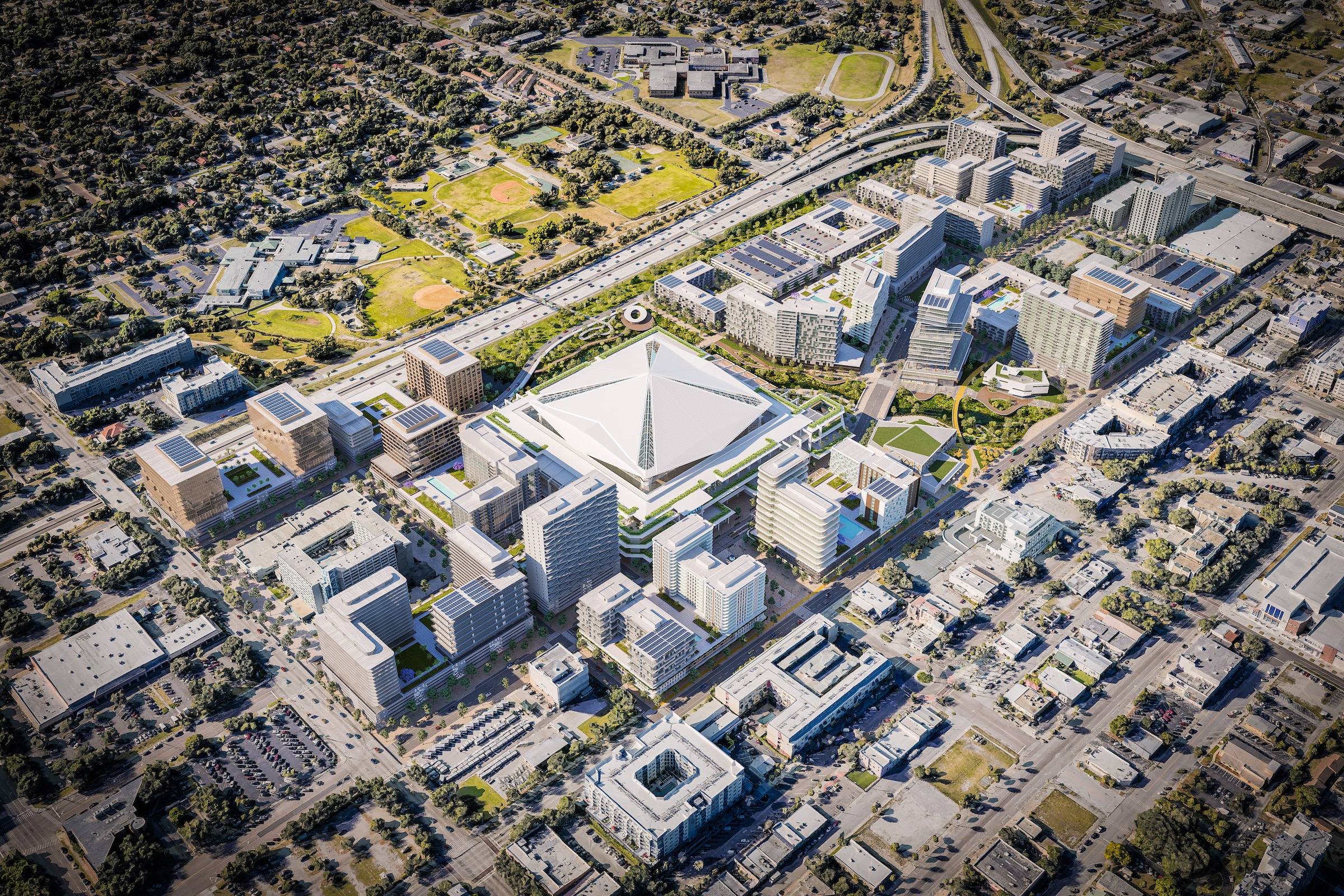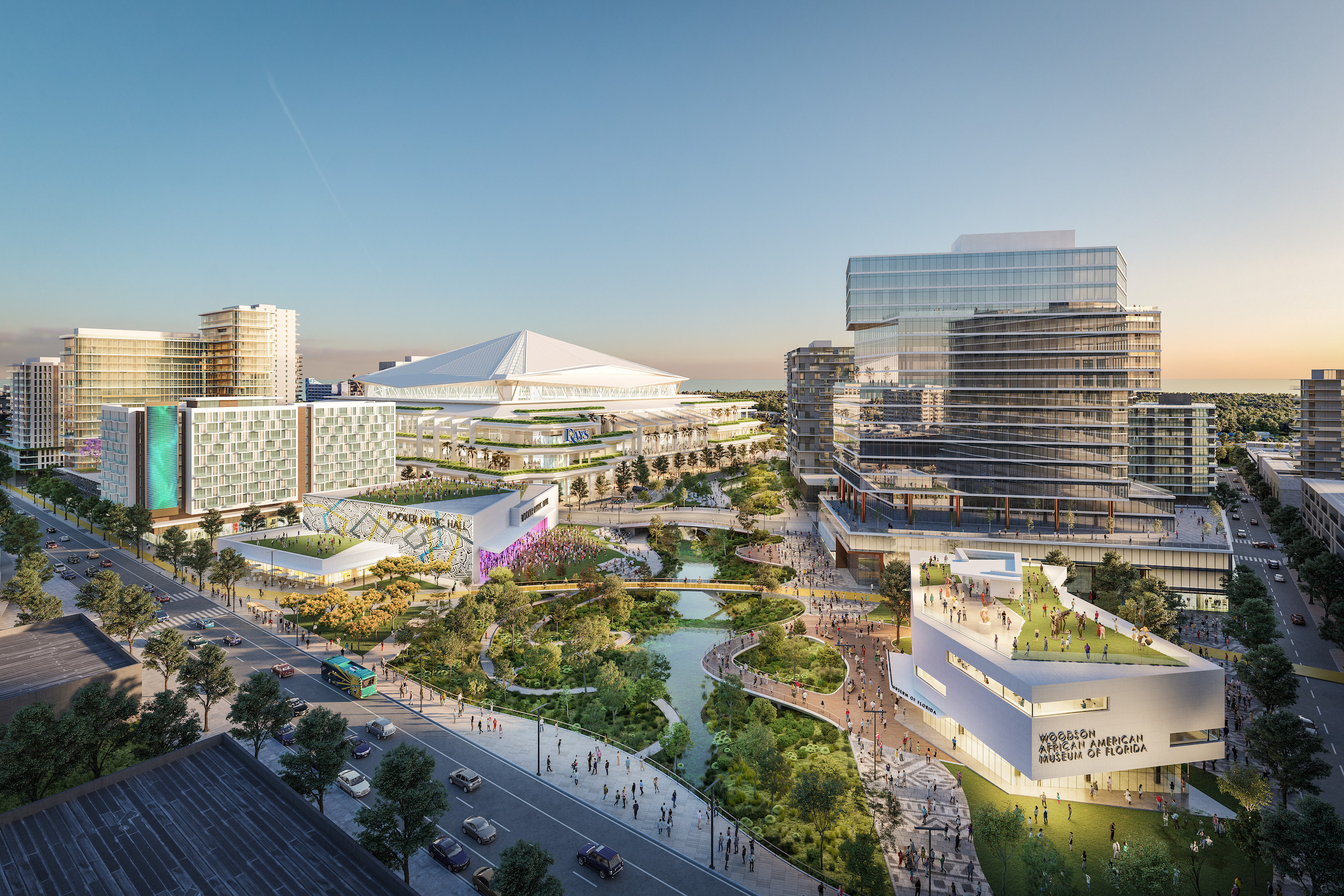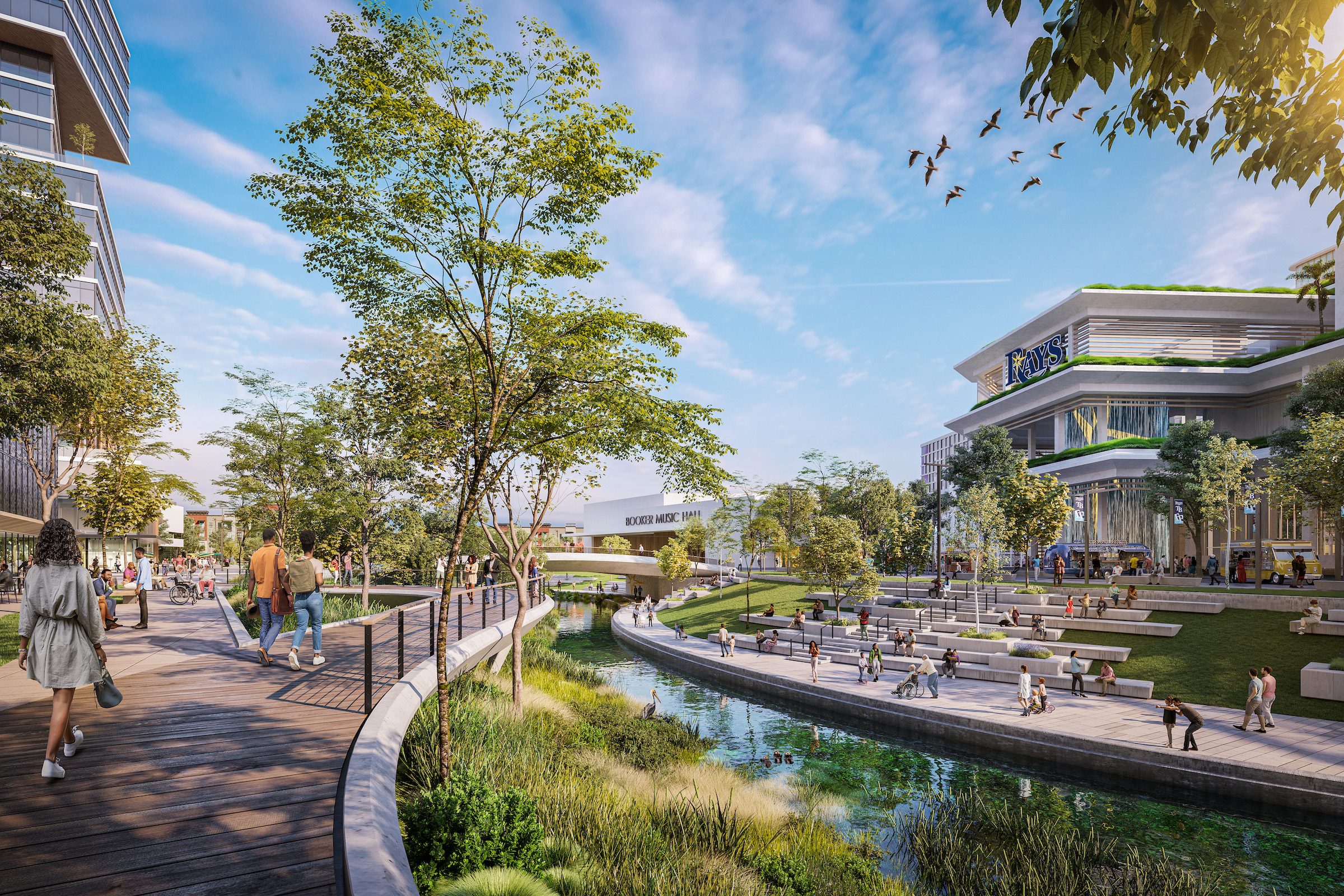In the late 1980s, an African-American neighborhood in St. Petersburg, Fla., known as the Historic Gas Plant District, was the victim of displacement by the city to make way for the construction of the Tropicana Field stadium.
Fast forward to September 19 of this year, when the Tampa Bay Rays Major League Baseball team announced that it had reached an agreement with St. Petersburg and Pinellas County on a $6.5 billion, 86-acre mixed-use development that will include a new 30,000-seat ballpark and an array of office, housing, hotel, retail, and restaurant space totaling 8 million sf. (The stadium will be between 850,000 and 950,000 sf.)
The first phase of this project’s 20-year buildout is scheduled to begin construction late next year and be completed by opening day of the 2028 baseball season.
The developer Hines, through its Historic Gas Plant Partnership, is the master developer on this project, which will occur on land currently occupied by Tropicana Field. Hines’ involvement includes a $50 million commitment to equity initiatives with South St. Petersburg that encompass affordable housing, employment and business support, education programs, and minority/women owned business enterprise hiring.
Part of Entertainment District trend
This project can be placed within a larger development trend for entertainment districts that are proliferating around the country. Among the metros where entertainment districts have been proposed, or are currently under construction, are Miami, Gainesville, and Pompano Beach, Fla.; Kansas City and St. Louis, Mo.; Anaheim, Calif.; Norman, Okla.; Clarksville, Tenn., and Springdale, Ark. In many cases, as in St. Petersburg, these districts are positioned as vital pieces of larger urban revitalization and economic growth campaigns.
The St. Petersburg project, when it’s completed, will increase the number affordable housing units built by the Partnership to 1,200, with at least half of those units to be built within the redeveloped district.
The project will include 4,800 market-rate housing units, 600 senior-living units, 1.4 million sf of office and medical space, 750,000 sf of retail, 750 hotel rooms, 100,000 sf of performance/event space that include a 3,000- to 4,000-seat concert hall; 100,000 sf of conference and meeting space, 50,000 sf of cultural and community space that encompasses the Carter G. Woodson African American Museum of Florida; 14 acres of public open space, and 14,000 parking spaces.
The Rays will pay more than half of the $1.3 billion cost to build the new ballpark, and the city and county will contribute an aggregate $600 million.
“Hines … is honored to bring this transformative, city-defining project to life,” said Michael Harrison, Senior Managing Director with Hines, in a prepared statement. “Our goal is to create St. Petersburg’s next great place to live, work, and play.”
The public approval process by the city and county is expected to start this fall.
Tampa Bay Rays, Hines finalize stadium-anchored multiuse district in St. Petersburg, Fla.




Related Stories
| Aug 11, 2010
Accor North America launches green hotel pilot program
Accor North America, a division of Accor Hospitality, has announced that it will pilot the Green Key Eco-Rating Program within its portfolio in the United States in 2010. Green Key is the first program of its kind to rank, certify and inspect hotels and resorts based on their commitment to sustainable "green" practices; the Accor North America pilot will involve 20 properties.
| Aug 11, 2010
CTBUH changes height criteria; Burj Dubai height increases, others decrease
The Council on Tall Buildings and Urban Habitat (CTBUH)—the international body that arbitrates on tall building height and determines the title of “The World’s Tallest Building”—has announced a change to its height criteria, as a reflection of recent developments with several super-tall buildings.
| Aug 11, 2010
Jacobs, Arup, AECOM top BD+C's ranking of the nation's 75 largest international design firms
A ranking of the Top 75 International Design Firms based on Building Design+Construction's 2009 Giants 300 survey. For more Giants 300 rankings, visit http://www.BDCnetwork.com/Giants
| Aug 11, 2010
See what $3,000 a month will get you at Chicago’s Aqua Tower
Magellan Development Group has opened three display models for the rental portion of Chicago’s highly anticipated Aqua Tower, designed by Jeanne Gang. Lease rates range from $1,498 for a studio to $3,111 for a two-bedroom unit with lake views.
| Aug 11, 2010
Architecture Billings Index flat in May, according to AIA
After a slight decline in April, the Architecture Billings Index was up a tenth of a point to 42.9 in May. As a leading economic indicator of construction activity, the ABI reflects the approximate nine to twelve month lag time between architecture billings and construction spending. Any score above 50 indicates an increase in billings.
| Aug 11, 2010
Construction employment declined in 333 of 352 metro areas in June
Construction employment declined in all but 19 communities nationwide this June as compared to June-2008, according to a new analysis of metropolitan-area employment data released today by the Associated General Contractors of America. The analysis shows that few places in America have been spared the widespread downturn in construction employment over the past year.
| Aug 11, 2010
Casino Queen breaks ground on $2.15 million entertainment venue
The Casino Queen in East St. Louis, Ill., is raising the stakes in its bid to capture a larger share of the local gaming market with the start of construction on a new $2.15 million sports bar and entertainment venue that will enhance the overall experience for guests.
| Aug 11, 2010
Outdated office tower becomes Nashville’s newest boutique hotel
A 1960s office tower in Nashville, Tenn., has been converted into a 248-room, four-star boutique hotel. Designed by Earl Swensson Associates, with PowerStrip Studio as interior designer, the newly converted Hutton Hotel features 54 suites, two penthouse apartments, 13,600 sf of meeting space, and seven “cardio” rooms.








